| |
| 
Department of Chemistry
5735 S. Ellis Ave. (GHJ 409)
Chicago, Illinois, 60637
yamamoto@uchicago.edu
773.702.5059 tel
773.702.0805 fax
View
Chemistry Bio
|
Research Interests:
Due in large part to the development of new reagents, chemists today have the ability to routinely carry out syntheses which would have been impossible to carry out a few decades ago. Proton plays an important role in most enzymatic reactions. A well designed acid catalysis is an excellent candidate, as a proton substitute, for man-made organic reactions. The goal of our research is to engineer an artificial proton of a special shape that can be utilized as an effective tool for chemical reactions by harnessing the high reactivity of the metal atom towards a variety of functional groups. This concept was initially researched by examining the influence of a specially designed organometallic reagent on various organic reactions. The successful discrimination observed lead to examine a more intricate question of enantioface differentiation, which was initially reported from our laboratory and is now widely expanded in the world. During the last decade the uninterrupted expansion of Lewis and Brønsted acid catalysis research has continued in organic synthesis. New catalysis research in our laboratory is targeting more versatile, more selective, and more reactive catalysts, aiming at environmentally benign systems. Nonetheless, the full potential of acid catalysts is still not yet realized. The following topics are recently being studied in our laboratories:
1. Combined acid catalysis of Lewis and Brønsted acids.
2. Asymmetric transformation of esterification, amidation, halogenation using designer acid catalysis.
3. Development of catalytic asymmetric reactions using optically active silver complexes.
4. Catalytic asymmetric oxidation using metal and non-metal catalyst.
5. Super Sily for one-pot and/or flow organic synthesis.
6. Super Brønsted Acid catalysis.
7. New metal catalysis using cis-Β-configuration.
Recent Selected Papers:
|

J. Saadi
|
Rapid, One-Pot Synthesis of β-Siloxy-α-Haloaldehydes. Saadi, J.; Akakura, M.; Yamamoto, H. J. Am. Chem. Soc., 2011, 133, 14248–14251.

The Mukaiyama cross-aldol reaction of α-fluoro-, α-chloro-, and α-bromoacetaldehyde-derived (Z)-tris(trimethylsilyl)- silyl enol ethers is described, furnishing anti-β-siloxy-α-haloaldehydes. Furthermore, highly diastereoselective, one-pot, sequential double-aldol process is developed, affording novel syn-syn-anti-configured β,δ-bissiloxy-α,γ-bishaloaldehydes. In addition, by switching solvent, all-syn double aldol product was also obtained. Reactions are catalyzed by C6F5CHTf2 and C6F5CTf2AlMe2 (0.5-1.5 mol%) and provide access to halogenated polyketide fragments.
|

M. Baidya
|
Metal Nitrite: A Powerful Oxidizing Reagent. Baidya, M., Yamamoto. H., J. Am. Chem. Soc. 2011, 133, 13880-13882.
An efficient and simple source of nitroso reagents and their oxidation reactions are described. The combination of a Lewis acid and a metal nitrite is applied to the oxidation of silyl enol ethers. Amino acid and peptide derivatives were easily accessed through in situ C-C bond cleavage of fully substituted silyl enol ethers upon oxidation.

|

Y. Nishikawa
|
Iron-Catalyzed Asymmetric Epoxidation of β,β-Disubstituted Enones.
Nishikawa, Y., Yamamoto, H. J. Am. Chem. Soc. 2011, 133, 8432-8435.
The combination of Fe(OTf)2 and novel phenanthroline ligands enables the catalytic asymmetric epoxidation of acyclic β,β-disubstituted enones, which have been a heretofore inaccessible substrate class. The reaction provides highly enantioenriched α,β-epoxyketones (up to 92% ee) that can be further converted to functionalized β-ketoaldehydes with an all-carbon quaternary center.

|

B. Albert

Y. Yamaoka
|
Rapid Total Syntheses Utilizing "Supersilyl" Chemistry Albert, B. J., Yamaoka, Y.; Yamamoto, H. Angew. Chem. Int. Ed. 2011, 50, 2610 -2612
In short order: The shortest total syntheses of natural product EBC-23 (see scheme, PMB=para-methoxybenzyl, TMS=trimethylsilyl) and a polymethoxy-1-alkene to date have been accomplished in just ten total steps each from commercially available chemicals. The syntheses took advantage of highly diastereoselective supersilyl-directed cascade polyaldol reactions.

|

D. Usanov
|
Enantioselective Alkynylation of Aldehydes with 1-Haloalkynes Catalyzed by Tethered Bis(8-quinolinato) Chromium Complex, Usanov, D. L.; Yamamoto, H. J. Am. Chem. Soc. 2011, 133, 1286–1289
The first example of Cr-catalyzed asymmetric alkynylation of aldehydes with 1-iodo- and 1-bromoalkynes was developed. The use of tethered bis(8-quinolinato) chromium catalyst (3 mol %) allowed preparation of enantioenriched propargyl alcohols with good yields and enantioselectivities up to 92% ee. 1-Bromoalkynes can be activated by the introduction of a cobalt porphine co-catalyst, which enables shorter reaction times without any loss of enantiocontrol.

|

Z. Li
|
Zirconium(IV)- and Hafnium(IV)-Catalyzed Highly Enantioselective Epoxidation of Homoallylic and Bishomoallylic Alcohols. Li Z.; Yamamoto, H. J. Am. Chem. Soc., 2010, 132, 7878–7880

In this report, zirconium(IV)− and hafnium(IV)−bishydroxamic acid complexes were utilized in the highly enantioselective epoxidation of homoallylic alcohols and bishomoallylic alcohols, which used to be quite difficult substrates for other types of asymmetric epoxidation reactions. The performance of the catalyst was improved by adding polar additive and molecular sieves. For homoallylic alcohols, the reaction could provide epoxy alcohols in up to 83% yield and up to 98% ee, while, for bishomoallylic alcohols, up to 79% yield and 99% ee of epoxy alcohols rather than cyclized tetrahydrofuran compounds could be obtained in most cases.
|

D. Usanov
|
Asymmetric Nozaki–Hiyama Propargylation of Aldehydes: Enhancement of Enantioselectivity by Cobalt Co-Catalysis. Usanov, D. L.; Yamamoto, H. Angew. Chem. Int. Ed. 2010, 49, 8169-8172

A combination of partially reduced chiral H8-TBOx chromium catalyst 1 and achiral cobalt porphine co-catalyst 2 (Ar=*p *-anisyl) led to an enhancement in enantioselectivity by suppression of the background process that presumably proceeds through an organomanganese species.
|

Y. Yamaoka
|
Super Silyl Stereo-Directing Groups for Complete 1,5-Syn and –Anti Stereoselectivities in the Aldol Reactions of -Siloxy Methyl Ketones with Aldehydes. Yamaoka, Y.; Yamamoto. H. J. Am. Chem. Soc., 2010, 132, 5354–5356

In this communication, we report that substrate-controlled 1,5-syn and -anti stereoinduction in the aldol reaction of β-tris(trialkylsilyl)siloxy methyl ketones can be achieved with high diastereoselectivities. Tris(trialkylsilyl)silyl groups are easily prepared and play an important role in the selectivities of these reactions. Furthermore, all of the 1,3,5-triol stereoisomers can easily be prepared from β-siloxy methyl ketones in no more than three steps.
|

B. Albert |
A Triple-Aldol Cascade Reaction for the Rapid Assembly of Polyketides. Albert, B. J., Yamamoto, H. Angew. Chem. Int. Ed. 2010, 49, 2747 -2749
Triple play: The title reaction of 1 with simple aldehydes gives 3,5,7-trisilyloxy aldehydes in high yields and diastereoselectivities with extremely low catalyst loading (see scheme). Iodobenzene facilitates the third aldol reaction by apparently acting as a Lewis base towards the silyl catalyst. Tf=trifluoromethanesulfonyl.

|

P. Li |
Lewis Acid Catalyzed Inverse-Electron-Demand Diels-Alder Reaction of Tropones. Li, P. F.; Yamamoto, H. J. Am. Chem. Soc., 2009, 131, 16628-16629.
Lewis acid catalyzed inverse-electron-demand Diels-Alder reaction of tropone derivatives was developed. Up to 97% ee was obtained for the chiral dinucleus BINOL-aluminum complex catalyzed reaction between tropones and ketene diethyl acetal to give bicyclo[3.2.2] ring structures, which opens up a unique way of making chiral seven-membered rings.

|

J. Abell |
Dual-Activation Asymmetric Strecker Reaction of Aldimines and Ketimines Catalyzed by a Tethered Bis(8-quinolinolato) Aluminum Complex. Abell, J.P., and Yamamoto, H. J. Am. Chem. Soc., 2009, 131, 15118-15119.
An aluminum complex was found to be high yielding and enantioselective for the addition of cyanide to aldimines and ketimines. Although catalytic asymmetric addition of cyanide to imines to generate a-amino-protected nitriles (the Strecker reaction) has been extensively studied in the past, alternative, easier-to-handle reagents for this process are required for modern organic synthesis. To date, there are a limited number of reports utilizing alternative sources of cyanide other than KCN/HCN or TMSCN for this important reaction. The present catalyst provides uniformly high enantioselectivity for aromatic, heteroaromatic, and aliphatic aldimines and ketimines using ethyl cyanoformate as the cyanide source.

|

J.N. Payette |
Cationic-Oxazaborolidine-Catalyzed Enantioselective Diels-Alder Reaction of α, β-Unsaturated Acetylenic Ketones. Payette, J. N.; Yamamoto, H. Angew. Chem., Int. Ed. 2009, 48, 8060-8062.
Yne also a good dienophile: The cationic oxazaborolidine 1 promoted the formation of Diels-Alder adducts between acetylenic ketones and both cyclic and acyclic dienes in excellent yield with 99 % ee (see scheme; Tf=trifluoromethanesulfonyl, TMS=trimethylsilyl). Importantly, high levels of asymmetric induction were also observed with dienophiles that lacked the typical hydrogen-bonding motif required for other oxazaborolidinium-mediated reactions.

|

P. Li |
Lewis Acid Catalyzed Inverse-Electron-Demand Diels-Alder Reaction of Tropones. Li, P. F.; Yamamoto, H. J. Am. Chem. Soc., 2009, 131, 16628-16629.
Lewis acid catalyzed inverse-electron-demand Diels-Alder reaction of tropone derivatives was developed. Up to 97% ee was obtained for the chiral dinucleus BINOL-aluminum complex catalyzed reaction between tropones and ketene diethyl acetal to give bicyclo[3.2.2] ring structures, which opens up a unique way of making chiral seven-membered rings.

|

P. Jiao |
Sequential O-Nitrosoaldol and Grignard Addition Process: A New Enantio- and Diastereoselective Entry to Chiral 1,2-Diols, Jiao, P., Kawasaki, M., Yamamoto H. Angew. Chem. Int. Ed., 2009, 48, 3333-3336.
Chiral 1,2-diols have been prepared from -aminoxylated aldehydes or cyclohexanone and Grignard reagents with L-proline or its tetrazole derivative as the catalyst. The presence of the ate complex of CeCl3 2 LiCl is essential for the high overall yields and good selectivities (see scheme; DMSO=dimethyl sulfoxide, THF=tetrahydrofuran)

|

Z. Li |
Vanadium-Catalyzed Enantioselective Desymmetrization of meso-Secondary Allylic Alcohols and Homoallylic Alcohols, Li, Z., Zhang, W., Yamamoto, H. Angew. Chem. Int. Ed. 2008, 47, 7520-7522.
Desymmetrization isn't complex: The substrate scope for vanadium-catalyzed epoxidation has been extended: In addition to various allylic alcohols, homoallylic alcohols can also be desymmetrized by using vanadium/bishydroxamic acid complexes (see scheme; CHP=cumene hydroperoxide).

|

J. Payette
|
Nitrosobenzene-Mediated C-C Bond Cleavage Reactions and Spectral Observation of an Oxazetidin-4-one Ring System, J. Am. Chem. Soc. 2008, 130, 12276-12278.
While bond formation processes have traditionally garnered the attention of the
chemical community, methods facilitating bond-breaking remain relatively undeveloped.
We have developed a novel, transition metal-free oxidative C-C bond cleavage process
for a broad range of ester and dicarbonyl compounds involving carbanion addition to
nitrosobenzene. ReactIR experiments on the nitrosobenzene-mediated oxidative
decarboxylation of esters indicate the reaction proceeds via fragmentation of a
previously unobserved oxazetidin-4-one heterocycle, characterized by an intense IR
stretching frequency at 1846 cm-1. These mechanistic studies have allowed further
expansion of this protocol to ketone cleavage reactions of a diverse array of
β-ketoester and 1,3-diketone substrates. The conceptual and mechanistic
insights offered by this study are likely to provide a platform for further
development of bond-breaking methodologies.
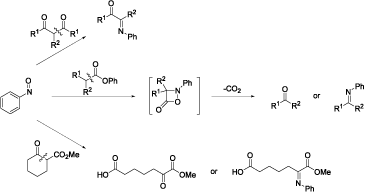
|

K. Shibatomi |
Stereoselective Synthesis of α,α-Chlorofluoro Carbonyl
Compounds Leading to the Construction of Fluorinated Chiral Quaternary
Carbon Centers, Shibatomi, K. Yamamoto, H., Angew. Chemie Int. Ed., 2008, 47, 5796-5798.
Asymmetric syntheses of α,α-chlorofluoro carbonyl compounds are described. α,α-Chlorofluoroaldehydes were successfully synthesized by organocatalytic fluorination of α-chloroaldehydes with up to >99:1 of enantiomeric ratio. A α,α-chlorofluoroketone was also synthesized by zirconium (IV) mediated asymmetric chlorination of fluorinated silyl enolate in a 94:6 enantiomeric ratio. Nucleophilic substitutions of this α,α-chlorofluoroketone with azide and thiol nucleophiles provided various optically active fluorinated molecules without any loss of the optical purity.

|

J. Abell |
Catalytic Enantioselective Pudovik Reaction of Aldehydes and
Aldimines with Tethered Bis(8-quinolinato) (TBOx) Aluminum Complex,
Abell, J.P., Yamamoto, H., J. Am. Chem. Soc., 2008,130, 10521-10523.
New chiral tethered bis(8-quinolinolato) (TBOx) aluminum(III) complexes effectively catalyze the addition of phosphites to aldehydes and aldimines to give enantioenriched α-hydroxy and α-amino phosphonates in high yields and enantioselectivities with unprecedented reactivity (TON =100 as high as 200). The catalyst is optimized with the low catalyst loading of 0.5 – 1.0 mol %. The modular synthesis of the catalyst allows for potential to tune the reaction for maximum catalytic activity. To date there are few examples with broad substrate scopes that can catalyze both aldehydes and aldimines with such high selectivity and no reports utilizing such low catalyst loading.
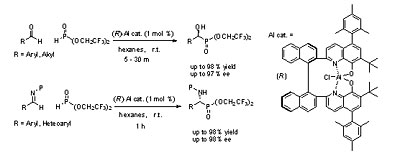
|

C. H. Cheon |
A Brønsted Acid Catalyst for the Enantioselective Protonation
Reaction, Cheon, C.H., Yamamoto, H., J. Am. Chem. Soc., 2008
,130, 9246-9247.
A highly reactive and robust chiral Brønsted acid catalyst, chiral N-triflyl thiophosphoramide, was developed. The first metal-free Brønsted acid catalyzed enantioselective protonation reaction of silyl enol ethers was demonstrated using this chiral Brønsted acid catalyst. The catalyst loading could be reduced to 0.05 mol % without any deleterious effect on the enantioselectivity.
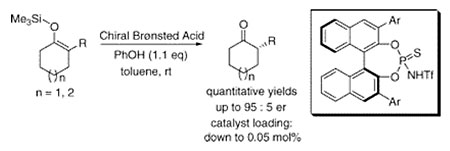
|

M. Kawasaki |
Enantioselective O-Nitroso Aldol Reaction of Silyl Enol Ethers, Kawasaki, M., Li, P., and Yamamoto, H., Angew. Chem. Int. Ed., 2008, 47, 3795-3797.
The enantioselective O-nitroso aldol reaction of nitrosobenzene and silyl enol ethers has been achieved with the use of silver and chiral phosphite ligand which was derived from BINOL. After various ligands and silver salts were surveyed, AgBF4 and chiral phosphite were optimal to obtain the O-nitroso aldol products with high enantio- and regioselectivity. The reaction has been applied to various silyl enol ethers which can be easily prepared. Thus, this improvement makes nitroso aldol reaction more practical and versatile.

|

P. Jiao |
Enantioselective 1,3-Dipolar Cycloaddition of Nitrones with Ethyl Vinyl Ether: The Difference
between Brønsted and Lewis Acid Catalysis, Jiao, P., Nakashima, D., and Yamamoto, H., Angew. Chem. Int. Ed., 2008, 47, 2411-2413.
A new chiral N-triflyl phosphoramide is used for asymmetric 1,3-dipolar cycloaddition of diaryl nitrones to ethyl vinyl ether to give the endo products in up to 93% ee. The structure of the chiral phosphoramide was confirmed by X-ray crystallographic analysis.

|

M. Boxer |
Ketone Super Silyl Enol Ethers in Sequential Reactions: Diastereoselective
Generation of Tertiary Carbinols in One Pot, Boxer, M. and Yamamoto, H.,
J. Am. Chem. Soc., 2008,130, 1580-1583.
Ketone super silyl enol ethers are shown to be excellent nucleophiles in the Mukaiyama aldol reaction as well as in sequential one-pot diastereoselective reactions. High yields and diastereoselectivities are obtained with a variety of silyl enol ether/aldehyde/Grignard combinations. The utility of this reaction is exemplified in a one-pot 4-component reaction generating two secondary and one tertiary alcohol in one step.

|

J. Payette |
Regioselective and Asymetric Diels-Alder Reaction of 1- and 2-Substituted Cyclopentadienes Catalyzed by a
Brønsted Acid Activated Chiral Oxazaborolidine, Payette, J., Yamamoto, H., J. Am. Chem. Soc.,
2007
, 129, 9536-9537.
Diels-Alder adducts derived from 1- and 2-substituted cyclopentadienes are potentially useful building
blocks of complex natural products. At temperatures >0 °C mono-substituted cyclopentadienes undergo a facile
[1,5]- sigmatropic rearrangement yielding a ~1:1 mixture of the 1- and 2-substituted isomers. Cationic
oxazaborolidine 2 affords Diels-Alder adducts of ethyl acrylate and 2-substituted cyclopentadienes, derived
from the corresponding mixture of regioisomers, as single isomers in excellent yields and ee’s.
Furthermore, Diels-Alder adducts of 1-substituted cyclopentadienes are obtained through a one-pot
procedure whereby ethyl acrylate is initially employed to consume all 2-substituted cyclopentadiene.
Subsequently, various 2,5-disubstituted benzoquinones are added to react with remaining 1-substituted
cyclopentadiene. Remarkably, reaction occurs selectively at the double bond coordinated anti to catalyst 2
to provide adducts containing adjacent all-carbon quaternary stereocenters in high yields and excellent
ee’s.
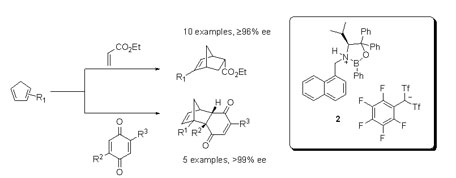
|

P. Li

J. Payette |
Enantioselective Route to Platensimycin: An Intramolecular Robinson
Annulation Approach, Li, P., Payette, J., Yamamoto, H., J. Am. Chem. Soc., 2007, 129, 9534.
Platensimycin, a novel antibiotic lead compound, is formally synthesized in an enantioselective fashion from simple starting materials in 10 steps. Highlights of this route include: (1) a regio- and enantioselective Diels-Alder reaction of methyl cyclopentadiene; (2) oxidative decarboxylation of an ester by using nitrosobenzene to give corresponding ketone; (3) a one-pot reductive cyanation of lactone; (4) a stereoselective intramolecular Robinson annulation to provide the key tetracyclic core structure of platensimycin.
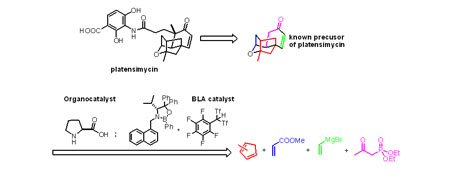
|

M. Boxer |
“Super Silyl” Group for Diastereoselective Sequential Reactions: Access to
Complex Chiral Architecture in One Pot, Boxer, M., Yamamoto, H. J. Am. Chem. Soc., 2007, 129, 2762.
We have shown that the tris(trimethylsilyl)silyl (TTMSS) silyl enol ether of acetaldehyde undergoes aldehyde cross-aldol reactions with high selectivity and the extremely low catalyst loading (0.05 mol % of HNTf2) allows for one-pot sequential reactions where acidic or basic nucleophiles can be subsequently added. Various ketone-derived silyl enol ethers, Grignard reagents, and dienes succeeded, generating relatively complex molecular architectures in a single step. This represents the first case where, in a single pot, highly acidic conditions followed by very basic conditions were tolerated to give products with high diastereoselectivities and good yields.
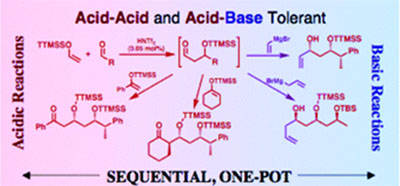
|

N. Momiyama

Y. Yamamoto |
Diastereo- and Enantioselective Synthesis of Nitroso Diels-Alder-Type Bicycloketones Using Dienamine: Mechanistic Insight into Sequential Nitroso Aldol/Michael Reaction and Application for Optically Pure 1-Amino-3,4-diol Synthesis, Momiyama, N., Yamamoto, Y., Yamamoto, H. J. Am. Chem. Soc., 2007, 129, 1190.
This article presents complete diastereo- and highly enantioselective synthesis of nitroso Diels-Alder-type bicycloketones using dienamine. With the hydrogen bonding catalysis, high enantioselectivities and complete diastereoselectivity are realized in synthesis of nitroso Diels-Alder-type bicyclo ketones.
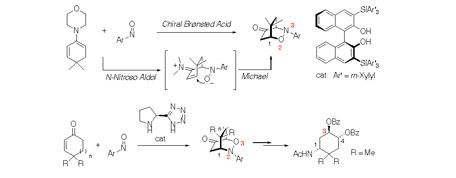
|

N. Takaneka

J. Abell |
Asymmetric Conjugate Addition of Silyl Enol Ethers Catalyzed by Tethered Bis(8-Quinolinolato) Aluminum Complexes, Takenaka, N;† Abell, J. P.; and Yamamoto, H. J. Am. Chem. Soc. 2007, 129, 742-743.
New chiral tetherted bis(8-quinolinolato) (TBOx) aluminum(III) complexes effectively catalyze the highly enantioselective Mukaiyama-Michael reaction of silyl enol ethers, including tetrasubstituted enolates that give rise to enantioenriched a-carbonyl all-carbon-substituted quaternary stereocenters. The present catalyst also promotes the conjugate addition of N-benzylindole to a,b-unsaturated acylphosphonates with high enantioselectivity (indole Friedel-Crafts alkylation reaction).
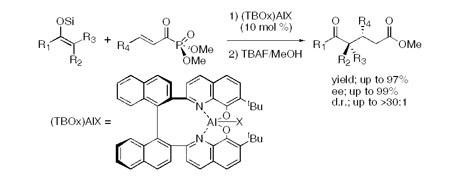
|

G. Xia |
Catalytic Enantioselective Allenylation Reactions of Aldehydes with Tethered
Bis(8-quinolinolato) (TBOx) Chromium Complex. Xia, G., Yamamoto, H. J. Am. Chem. Soc., 2007, 129, 469-497
The utility of the new class of chiral ligand, tethered bis(8-quinolinol) (TBOxH) is further explored. Its chromium complex, TBOxCr(III)Cl, effectively catalyzes the asymmetric allenylation reactions of various aldehydes at room temperature with high yields (up to 91%), and high enantioselectivities (up to 97% ee). The scope of the present method is shown to be wide and this method represents an efficient access to chiral α-allenic alcohols.

|

W. Zhang |
Vanadium-Catalyzed Asymmetric Epoxidation of Homoallylic Alcohols. Zhang, W.; Yamamoto, H. J. Am. Chem. Soc., 2007, 129, 286-287.
New chiral bishydroxamic acids were synthesized and tested as chiral ligands in the vanadium-catalyzed asymmetric epoxidation of homoallylic alcohols to provide good yields and high enantioselectivities.
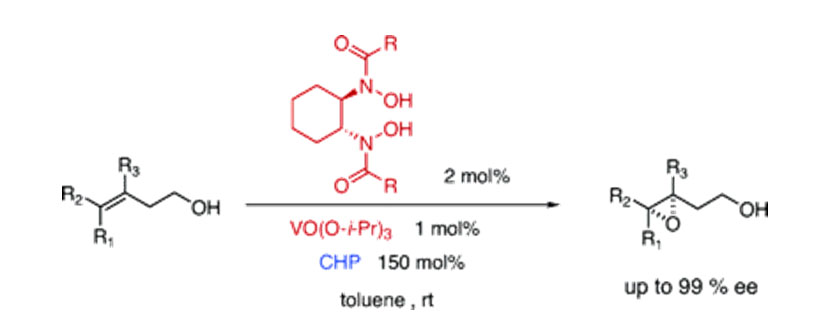
|

M. Kawasaki |
Catalytic Enantioselective Hetero-Diels-Alder Reactions of an Azo Compound,
Kawasaki, M., Yamamoto H., J. Am. Chem. Soc., 2006, 128, 16482-16483.
This communication describes studies in which azo hetero-Diels-Alder adduct was furnished in high regio- and enantioselectivity using azopyridine as a reagent and silver as a catalyst. The obtained hetero-Diels-Alder adduct was easily converted to the corresponding chiral 1,4-diamino alcohol.

|

A. U. Barlan

A. Basak |
Enantioselective Oxidation of Olefins Catalyzed by a Chiral bishydroxamic Acid Complex of Molybdenum. Barlan, A. U.; Basak, A.; Yamamoto, H. Angew. Chem. Int. Ed. Enl., 2006, 45, 5849-5852.
Up to excellent yields and enantioselectivities were achieved for the molybdenum-bis hydroxamic acid catalyzed asymmetric oxidation of olefins in air at room temperature. The use of achiral oxidants with molybdenum catalyst can tolerate a range of terminal, cis-, and tri-substituted olefins that can provide good to excellent selectivity. Furthermore, this approach oxidizes the most electron rich alkene in the presence of multiple double bonds, shown by the direct oxidation of myrcene and squalene.
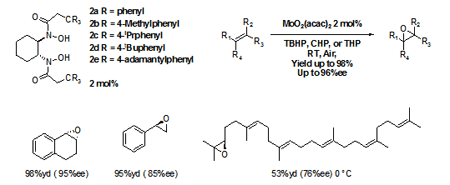
|

D. Nakashima |
Design of Chiral N-Triflyl Phosphoramide as a Strong Chiral Brønsted Acid and its application to Asymmetric Diels-Alder Reaction, Nakashima, D.; Yamamoto, H., J. Am. Chem. Soc. 2006, 128, 9626.
Strong chiral Brønsted acid was developed by introduction of a strong electron acceptor into chiral phosphoric acid. This strong chiral Brønsted acid, N-Triflyl phosphoramide, effectively catalyzes asymmetric Diels-Alder reaction of a,b-unsaturated ketone with silyloxydiene.
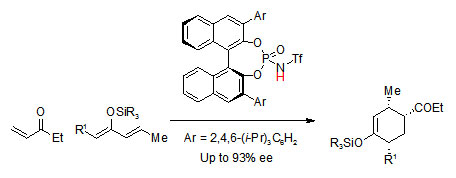
|

G. Xia |
Catalytic Enantioselective Nozaki-Hiyama Allylation Reaction with Tethered Bis(8-quinolinolato) (TBOx) Chromium Complex. Xia, G; Yamamoto, H. J. Am. Chem. Soc., 2006, 128, 2554.
The utility of the new class of chiral ligand, tethered bis(8-quinolinol) (TBOxH) is further explored. Its chromium complex, TBOxCr(III)Cl, effectively catalyzes the Nozaki-Hiyama allylation reactions of various aldehydes at room temperature with high yield (up to 95%), and high enantioselectivity (up to 99% ee). The scope of the present method is shown to be wide and this method represents an efficient access to chiral homoallylic alcohols.

|

M. B. Boxer |
Tris(trimethylsilyl)silyl-Governed Aldehyde Cross-Aldol Cascade Reaction. Boxer, M. B.; Yamamoto, H. J. Am. Chem. Soc. 2006, 128, 48.
The use of the tris(trimethylsilyl)silyl (TTMSS) group in aldehyde derived silyl enol ethers affords aldehyde cross-aldol products with high yields and allows for unprecedented reactivity. The reaction is catalyzed by 0.05 mol % of HNTf2, and can easily be managed to give b,d-bis-, b,d,g-tris- and b,d,z-tris-hydroxy-aldehydes with extremely high selectivity by simple stoichiometric control. High diastereoselectivity is obtained in all cases and the use of chiral aldehydes affords Felkin products when there are non-chelating substituents, chelation products when there is a chelating sbustituent and syn products when there is b-substitution. HNTf2 is proposed to be an initiator, and highly Lewis acidic TTMSSNTf2 is the true catalyst.
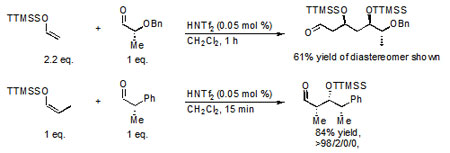
|

N. Momiyama |
Brønsted Acid Catalysis of Achiral Enamine for Regio- and
Enantioselective Nitroso Aldol Synthesis. Momiyama, N.; Yamamoto, H.
J. Am. Chem. Soc.,2005, 127, 1080.
Two types of chiral Brønsted acid catalyst have been shown to catalyze regio- and enantioselective nitroso aldol synthesis between nitrosobenzene and achiral enamine. The combination of Brønsted acidity and amine moiety of enamine realizes completely regioselectivity and highly enantioselectivity. After survey of Brønsted acid catalyst, 1-nap glycolic acid is found to be optimal in O-nitroso aldol pathway, on the other hand, 1-naphtyl TADDOL is best catalyst for N-nitroso aldol pathway. This is based on our finding about control of regioselectivity by changing the amine moiety of enamine and choice of Brønsted acidity.
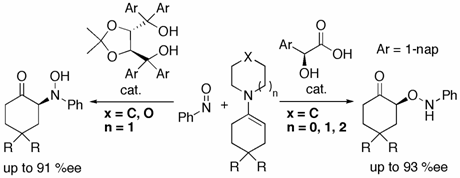
|

A. Basak

W. Zhang |
Enantioselective Epoxidation of Allylic Alcohols by a Chiral Complex of Vanadium: An Effective Controller System and A Rational Mechanistic Model. Zhang, W.; Basak, A.; Kosugi Y.; Hoshino, Y.; Yamamoto, H. Angew. Chem. Int. Ed. Enl. 2005, 44, 4389.
Chiral bishydroxamic acids were synthesized from diamine tartratesalt and were tested as chiral ligands in the vanadium catalyzed asymmetric epoxidation of allylic alcohols to provide good yields and high enantioselectivities. Plausible transition state was proposed to explain the enantioselectivity.
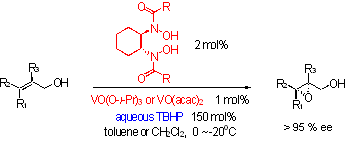
|

M. Boxer |
Remarkable Tris(trimethylsilyl)silyl Group for Diastereoselective [2 + 2] Cyclizations
Boxer, M. B.; Yamamoto, H. Org. Lett.2005, 7, 3127.
We have developed an efficient 2 + 2 cyclization reaction utilizing tris(trimethylsilyl)silyl (TTMSS) derived silyl enol ethers. Yields of cyclobutane adducts of up to 94% and with 99% diastereoselectivity have been achieved. The use of enol ethers with silyl groups containing silicon-silicon bonds were found to be necessary to obtain 2 + 2 adducts, and the TTMSS group was determined to be superior. The bulky Lewis acid, bis(2,6-diphenyl-phenoxide) aluminum triflimide, in conjunction with the TTMSS enol ethers was found to give exceedingly high yields and diastereoselectivities compared to other Lewis acid/ silyl enol ether combinations. This represents the first 2 + 2 condensation of aldehyde derived silyl enol ethers and acrylates to date.

|

Y. Yamamoto |
Catalytic Asymmetric Nitroso Diels--Alder Reaction with Acyclic Dienes, Yamamoto, Y.; Yamamoto, H. Angew. Chem. Int. Ed., 2005, 44, 7082-7085.
A new pathway to chiral aminoalcohols starting from enone was accomplished by catalytic asymmetric nitroso Diels --Alder reaction with silyloxy dienes. This new transformation proceeded with high enantio-, regio-, and diastereoselectivities with wide scope of substrates. Products could be converted to the protected amino alcohols, which are frequently found in a number of important natural products. Furthermore, dramatic differences are found in the reactivity of the silyloxy dienes. The bulkiness on the silicon group forces the diene to form an s-cis configuration in favor of the concerted [4 + 2] cycloaddition reaction which is advantageous for asymmetric Diels -- Alder reaction.

|
|

N. Momiyama |
Catalytic Enantioselective Synthesis of α-Aminooxy and α-Hydroxy
Ketone Using Nitrosobenzene, Momiyama, N.; Yamamoto, H. J. Am.
Chem. Soc. 2003, 125, 6038.
The highly enantioselective
reaction of tin enolates has been developed with (R)-BINAP-Silver
complexes as a catalyst. The product can be converted to
α-hydroxy ketone cleanly by the treatment of CuSO4 in MeOH
without any loss of enantioselectivity. This method opens a new
efficient entry to catalytic enantioselective introduction of oxygen
α to carbonyl group.

|
|

N. Momiyama |
Enantioselective O- and N-Nitroso
Aldol Synthesis of Tin Enolate. Isolation of Three BINAP-Silver Complexes and Their
Role on Regio- and Enantioselectivity, Momiyama, N.; Yamamoto, H. J. Am. Chem.
Soc. 2004, 126, 5360.
The selective generation of three
different complexes has been achieved via proper combination of metal/ligand ratio
and/or choice of silver salt. After the evaluation of each species, 1:1 (AgX·(R)-BINAP)
complex was found to play an important role for the enantioselective O-nitroso aldol
synthesis. On the other hand, the use of 2:1 (AgX·(R)-BINAP) complex in ethylene glycol
diethyl ether is essential to induce N-selectivity with high enantioselectivity. Thus,
2:1 (AgX·(R)-BINAP) complex reacted with a wide range of cyclic tin enolate to afford
α-hydroxyamino ketones in high enantioselectivities.
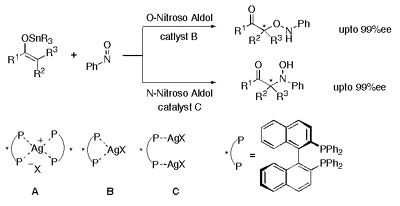
|
|

N. Momiyama |
O-Nitroso Aldol Synthesis.
Catalytic Enantioselective Route to α-Aminooxy Carbonyl
Compounds via Enamine Intermediate, Momiyama, N.; Torii, H.; Saito, S.; Yamamoto,
H. Proc. Nat. Acad. Sci. U. S. A. 2004, 101,
5374
The approach using pyrrolidine
enamine as substrate was designed to identify important catalyst structural features
for enantioselective O-nitroso aldol synthesis of carbonyl compounds via enamine
intermediates. After survey of pyrrolidine-based Brønsted acid catalyst,
tetrazole catalyst was found to be optimal in synthesis of aminooxy carbonyl compounds
in high yields with complete enantioselectivity not only for aldehydes but also for
ketones.

|
|

Y. Yamamoto |
Catalytic, Highly Enantio and Diastereoselective Nitroso Diels-Alder Reaction,
Yamamoto, Y.; Yamamoto, H. J. Am. Chem. Soc., 2004,
126, 4128-4129
Nitroso Diels-Alder reaction is a powerful reaction which two functional groups
can be induced in cis fashion in a single step. We have demonstrated the first
catalytic asymmetric version of this reaction using chiral Cu(I) catalysis. The key
was employing nitrosopyridine as a nitroso substrate to facilitate the chelate
association with Cu(I) catalysis. The obtained Diels-Alder adduct was easily
transformed to protected cis-amino alcohol which is an attractive intermediate for
natural product synthesis.

|
|

Y. Zhang |
Lewis Acid-Mediated Selective Chlorinations of Silyl Enolate, Zhang, Y., Shibatomi, K., and H. Yamamoto*,
J. Am. Chem. Soc., 126 (46), 15038 -15039, 2004.
A new method involving efficient, widely applicable, and highly selective α-chlorination of simple silyl enolate with Lewis acid and an α,α-dichloro-1,3-dicarbonyl controller unit was reported. Diastereoselectivity and enantioselectivity of the reaction were investigated. High reactivity and selectivity were achieved by using α,α-dichlorinated malonic ester.
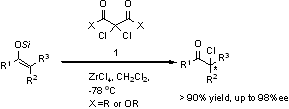
|
|

Y. Yamamoto

N. Momiyama |
Enantioselective Tandem O-Nitroso Aldol/Michael Reaction, Yamamoto, Y.; Momiyama,
N.; Yamamoto, H. J. Am. Chem. Soc., 2004, 126,
5962-5963
A sharply contrasting method to obtain chiral nitroso Diels-Alder adduct was
developed by tandem O-nitroso aldol/Michael reaction. Pyrrolidine based tetrazole
catalysis was found to be the best catalysis for this transformation. The
iminium intermediate played an important role to enhance the Michael addition
step to give the cyclized Diels-Alder adduct. The observed regioselectivity
was opposite from that of Cu(I) catalyzed nitroso Diels-Alder reaction.
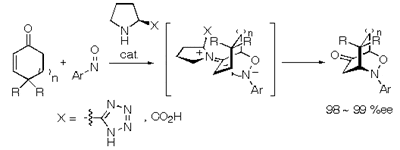
|
|

K. Futatsugi |
Oxazaborolidine-Derived Lewis Acid Assisted Lewis Acid as a Moisture-Tolerant Catalyst for Enantioselective Diels–Alder Reactions. Futatsugi, K.; Yamamoto, H. Angew. Chem. Int. Ed. Enl., 2005, 44, 1484-1487.
Lewis acid assisted chiral Lewis acid (LLA), generated from 1 and SnCl4, is recognized as a highly reactive and enantioselective Diels-Alder catalyst for various classes of substrates. The reactive species is able to preserve its asymmetric induction ability even in the presence of a large excess amount of SnCl4. Importantly, this catalyst system is tolerant to a small amount of moisture, oxygen, and other Lewis bases.

|
|

N. Takenaka

G. Xia |
Catalytic, Highly Enantio- and Diastereoselective Pinacol Coupling Reaction with a New Tethered Bis(8-quinolinolato) Ligand. Takenaka, N.; Xia, G.; Yamamoto, H. J. Am. Chem. Soc. 2004, 126, 13198-13199.

A new class of chiral ligand, tethered bis(8-quinolinol) (TBOxH) is developed. Its chromium complex, TBOxCrCl, (3 mol%) effectively catalyzes the pinacol coupling reaction of aromatic aldehydes at room temperature with high yield (up to 94%), high diastereoselectivity (up to dl : meso = 98 : 2), and high enantioselectivity (up to 98%). The scope of the present method turns out not to be limited to aromatic aldehyde derivatives, as cyclohexanecarboxaldehyde undergoes pinacolization as well (44% yield, dl : meso = 93 : 7, 84% ee). The method provides an efficient access to enantioenriched 1,2-diols.
|
| |
Recent Published Reviews: |

J. Abell |
Development and applications of tethered bis(8-quinolinolato) metal complexes (TBOxM). Abell, JP; Yamamoto, H. Chem. Soc. Rev., 2010, 39, 61 - 69.
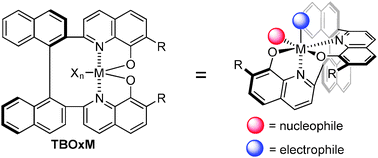
The tethered bis(8-quinolinolato) metal (TBOxM) complexes have found practical use in many asymmetric reactions. The development of highly enantioselective reactions using TBOxM is surveyed. General reaction schemes and examples using these highly active and selective catalysts are given and discussed in this tutorial review.
|

M. Boxer |
The Super Silyl Group in Diastereoselective Aldol and Cascade Reactions, Yamamoto, H.; Boxer, M.B.; Albert, B.J., Aldrichimica ACTA, 2009, 42, 3-15.
|

H. Yamamoto |
New reaction and new catalyst-a personal perspective, Yamamoto, H., Tetrahedron, 2007, 63, 8377-8412.
|

M. Wadamoto |
Silver Catalyzed Asymmetric Allylation: Allytrimethoxysilane as a Remarkable Reagent, Yamamoto, H.; Wadamoto, M., Chem. Asian J., 2007, 629-698.
Recently there have been some reports on the reaction using allytrimethoxysilane for enantioselective allylation with various metal fluorides or a combination of chiral complex and fluoride anion. These reactions can be applied for not only aldehyde but also ketone and imine. In this review, we focus on the development of asymmetric allylation of allytrimethosysilane with chiral silver complex.
|

M. Kawasaki |
Nitroso and Azo Compounds in Modern Organic Synthesis: Late Blooming but Very Rich, Yamamoto, H., M. Kawasaki, Bull. Chem. Soc. Jpn., 2007, 80, 595-607.
The catalytic enantioselective oxidation is an extremely important process in organic synthesis and numbers of effort to improve this process have been reported so far. Although nitroso and azo compounds are attractive tools for hydroxylation and amination of organic compounds, no reports on a catalytic asymmetric version of these reactions had been reported until recently. The main issues were their high and unique reactivities. In this review, we would like to introduce the recent advances in this area.
|

G. Xia |
Asymetric Catalytic Redox System: Tetherd Bis(8-quinolinolato) (TBOx) Chromium(III/II) Complexes, Yamamoto, H.; Xia, G., Chem. Let., 2007, 36, 1082-1087.
The TBOxCr(III)Cl/TBOxCr(II) system is ideal for catalytic asymmetric redox process. Because of the electron density of the TBOxH ligand high turnover numbers are expected, hence allowing decrease in the chromium catalyst loadings and acceleration of the reaction rate. High reactivity and high diastereo-/enantioselectivity are shown in asymmetric pinacol coupling reactions of aldehydes, asymmetric NH allylation reaction of aldehydes, asymmetric allenylation reactions of aldehydes, and some other reactions. These proceed exceedingly efficiently catalyzed by the TBOxCr(III)Cl redox system due to the well designed chiral environment of the ligands and the cis-β configuration of the center Cr meta
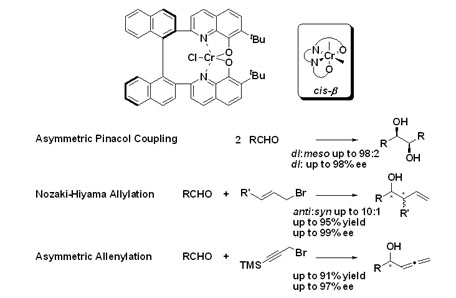
|

M. Boxer |
Super Brønsted Acid Catalysis in Organic Synthesis, Yamamoto, H., Boxer, M., Chimia Orgnatocatalysis, 2007, 61, 279-281.
This mini-review concerns the rapidly growing field of Brønsted acid catalysis. Brønsted acid catalysts are able to play an important role in green chemistry. Without the use of any transition metal catalysts, various organic transformations including asymmetric synthesis can be performed efficiently. This review summarized our recent results in this field.
|

Y. Yamamoto |
Recent Advances in Asymmetric Nitroso DielsAlder Reaction, Recent Advances in Asymmetric Nitroso DielsAlder Reactions, Yamamoto, Y.; Yamamoto, H. Eur. J. Org. Chem. 2006, 2031.
This review article summarizes the recent advances of asymmetric nitroso DielsAlder reaction. This paper was cited as the top ten most accessed paper for European Journal of Organic Chemistry for month of April 2006.
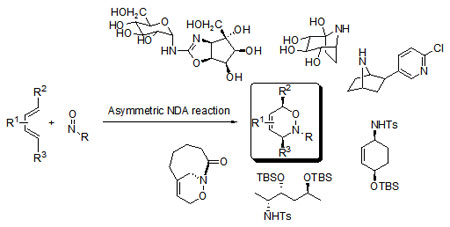
|

K. Futatsugi |
“Designer Acids”: Combined Acid Catalysis for Asymmetric Synthesis, H. Yamamoto, K. Futatsugi, Angew. Chem. Int. Ed. 2005, 44, 1924.
The concept of combined acids, which can be classified into Brønsted acid assisted Lewis acid (BLA), Lewis acid assisted Lewis acid (LLA), Lewis acid assisted Brønsted acid (LBA), and Brønsted acid assisted Brønsted acid (BBA), has great potential to be a particularly useful tool for the design of asymmetric catalysis, leading to high reactivity, selectivity, and versatility .
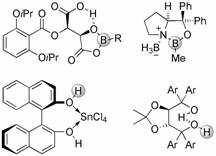
|

N. Momiyama |
Rich chemistry of nitroso compounds, Momiyama, N.; Yamamoto, H. Chem. Commun. 2005, 3514.
This review article summarizes the recent advances of nitroso compounds, both in aldol-type and hetero Diels-Alder reaction, that has been carried out primarily in our laboratory. This paper was cited as the top ten most accessed paper for the month of July.
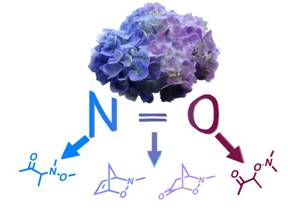
|
|
|
Back to top |
|



